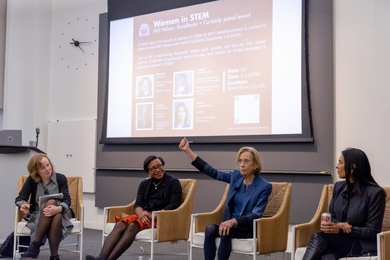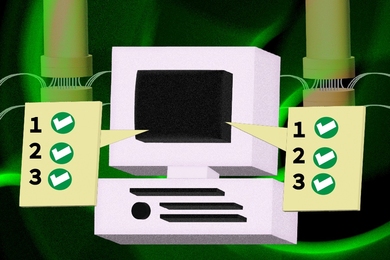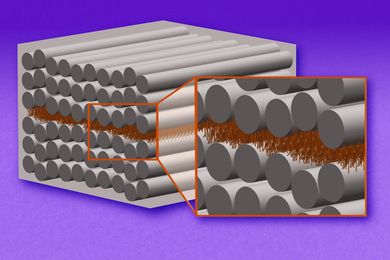CAMBRIDGE, Mass. -- A Massachusetts Institute of Technology researcher believes that substances that look and act like Flubber may hold the key to how life began.
Gels are oddly lifelike substances somewhere between a solid and a liquid. Jello, boiled egg and tofu are natural gels; synthesized gels are used to cushion the inner soles of athletic shoes and to absorb liquid in diapers.
About 20 years ago, MIT physicist Toyoichi Tanaka found that both synthetic and natural gels change phases in response to changes in their environment, much like water turning to vapor and back again.
Tanaka, the Otto and Jane Morningstar Professor of Science, is now looking to gels to provide a clue to the baffling puzzle of how life on Earth began. "By understanding the phase transitions of gels, we can better understand protein functions, the molecular basis of life," he said.
Life boils down to amino acids. Made up of different sequences of 20 amino acids, proteins twist into shapes that they "remember;" they recognize certain molecules and can store and release them as necessary; they help life-sustaining chemical reactions take place. They line up in chains called polymers.
A gel is a polymer, a long chain of identical monomers, or molecules, that are cross-linked like a web of fibers. It is those links, which capture water between them, that give gels their elasticity and fluidity.
Scientists can determine the sequence of amino acids that make up specific proteins, but they don't know how to make one from scratch.
Tanaka says that his laboratory may be close to synthesizing a gel with characteristics similar to those of proteins capable of recognizing a target molecule. What's more, he can do this without specifying the gene sequences to "build" the protein artificially.
"This may be a crude model of 'prebiotic polymerization,' which is a key step in the origin of life and prebiotic evolution," he said. "Some sort of prearrangement of the individual amino acid or nucleotide molecules that join together in a certain shape and sequence to make the polymer, possibly in the presence of some target molecule, can be easily imagined to exist in the primordial soup," he said.
The current theory holds that back in the Earth's early days, amino acids swimming around in a primordial soup randomly came together in a viable sequence. This theory doesn't hold much water with Tanaka. For one thing, he says, there hasn't been enough time since the beginning of the universe to try all the possible combinations. With 20 existing amino acids and 400 possible working sequences, that is a mind-boggling number.
"There is no way that amino acids happened upon the one particular sequence for a protein such as hemoglobin by accident," he said.
So Tanaka, as if seeking to fathom the intentions of an inventor when all he had was the inventor's wondrous but complex machine, posed questions about why the machine works the ways it does. "What has to happen to create a string of proteins called a polymer? Why did polymers acquire their particular properties? What do they need to do their jobs?" he asked.
Polymers make up proteins, genetic material and synthetic substances such as nylon. The chemical makeup of each polymer gel determines with which substance it will interact. Like a Venus flytrap lying in wait, one kind of gel may have open oxygen bonds available to capture any oxygen molecules that happen along. Hemoglobin are protein polymers that can, with a slight change in pH, capture oxygen in the lungs and release it in the muscles. In the brain, neurotransmitters are released and captured by protein receptors.
Knowing that certain polymers react with target substances, Tanaka and his colleagues created a computer simulation of their own primordial soup, throwing together a target substance and a slew of monomers. Their goal: to design a synthetic protein that recognizes a target molecule the way hemoglobin recognizes oxygen.
Amazingly, left to their own devices in the presence of the target substance, the monomers fell into place like tumblers in a lock fitted with the right key. At the right temperature, the monomers fell into a conformation that uses the least possible energy. Then, the monomers were polymerized, or frozen in sequence like beads on a string.
Not only did Tanaka and his colleagues create a theoretical polymer, the resulting gel, like the real McCoy, "remembered" its conformation after it was subjected to solvent, salt, different temperatures, acidity levels and general environment. No matter how they manipulated it, it could still fold into the original conformation and capture the target molecule.
"We call this imprinting," Tanaka said. "We know we imprinted when we made this gel because it absorbs the target. It's proof that it 'remembers' its conformation."
Besides providing a crude model for the creation of life, the research also has implications for creating synthetic compounds that have never been created before.
"If you can make a polymer that memorizes conformation, you can make polymers that recognize molecules. If you can make polymers, you should be able to make artificial enzymes that recognize transition states," Tanaka said. "With this technique, you can do anything life does."
The possible uses of gels
Gels can be "trained" to act appropriately in the presence of different substances. Scientists can make them even smarter by tweaking the way the gels are made to keep them poised between forces of expansion or contraction. This makes them react differently as needed.
While gels are widely used in medicine, food products, agriculture and chemistry, "smart" gels are a new class of materials. When you change the gels' environment, it reaches a point where it abruptly and dramatically swells or shrinks. Small changes in temperature, light, acidity, electrical field or solvent can cause both synthetic and natural gels to swell up to thousands of times their normal size or deflate just as quickly. In one state, a smart hydrogel's molecules may expel water. Tweak it slightly, and it becomes water-loving, sucking up every available molecule.
This is called a phase change, and these can help put gels to work to perform useful jobs.
Because one phase change allows certain gels to encapsulate and then release substances, they are being considered for applications ranging from cleaning up pollutants to releasing pharmaceuticals slowly in the body. They are the basis for new products such as cosmetics that release fragrance in response to skin pH.
Gels' softness and ability to undergo these huge but reversible changes in volume has unleashed a torrent of new ideas for their use.
They can be used for "soft" valves and switches. Gels swelling and shrinking could make good artificial muscles. "That's the beauty of it," Tanaka said. "Depending on what a gel interacts with, it will have different behaviors."





